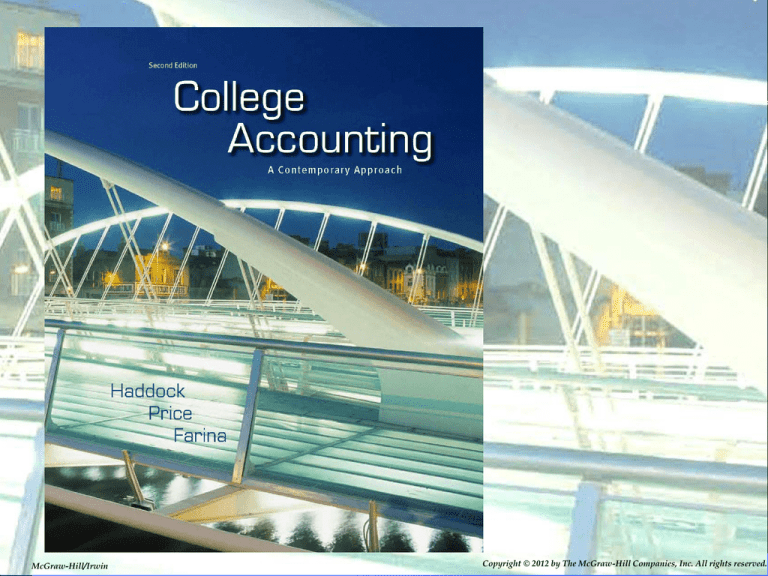
McGraw-Hill/Irwin
1-1
Copyright © 2012 by The McGraw-Hill Companies, Inc. All rights reserved.
4–1
Chapter
4
The General Journal and
the General Ledger
Section 1: The General Journal
Section Objectives
1. Record transactions in the
general journal.
2. Prepare compound journal
entries.
4–2
The Accounting Cycle
Step 1
Analyze
Analyze
and
transactions
classify
transactions
Step 2
Journalize
Journalize
the
transactions
data about
transactions
Step 3
Post
transactions
to the ledger
Step 4
Prepare
a
worksheet
Step 5
Prepare
financial
statements
Step 9
Evaluate and
communicate
financial
information
Step 8
Prepare a
postclosing
trial balance
Step 7
Journalize
closing
entries
Step 6
Journnalize
adjusting
entries
4–3
Objective 1
Record transactions in the general
journal
Journal
A journal is a diary of business activities.
There are different types of accounting
journals.
Transactions are entered in the journal in
chronological order.
4–4
GENERAL JOURNAL
DATE
DESCRIPTION
POST.
REF.
1
PAGE
DEBIT
CREDIT
2013
Nov.
6 Cash
100,000.00
Carolyn Wells, Capital
100,000.00
Enter the account to be debited.
Enter the amount on the same line in the Debit column.
Enter the account to be credited.
Enter the amount on the same line in the Credit column.
4–5
Recording a
Business Transaction
1. Analyze the financial event.
Identify the accounts affected.
Classify the accounts affected.
Determine the amount of increase or decrease for each account
affected.
2. Apply the rules of debit and credit.
a. Which account is debited? For what amount?
b. Which account is credited? For what amount?
3. Make the entry in T-account form.
4. Record the complete entry in general journal form.
4–6
Chapter
4
The General Journal and
the General Ledger
Section 2: The General Ledger
Section Objectives
3.
Post journal entries to
general ledger accounts.
4.
Correct errors made in
the journal or ledger.
4–7
Ledgers
The
ledger contains a separate form for
each account.
The
third step of the accounting cycle is
posting to the ledger.
The
process of transferring data from the
journal to the ledger is known as posting.
4–8
Posting
QUESTION:
What is posting?
ANSWER:
Posting is the process of
transferring data from a journal to a
ledger.
4–9
Ledger Account Forms
On the ledger account form shown below, notice the:
Account name and number
Columns for date, description, and posting reference
Columns for debit, credit, debit balance, and credit
balance
ACCOUNT
DATE
2013
Nov. 6
DESCRIPTION
ACCOUNT NO.
CASH
POST.
REF.
J1
DEBIT
100,000.00
CREDIT
101
BALANCE
DEBIT
CREDIT
100,000.00
4–10
Objective 3 Post journal entries to general ledger
accounts
Five Steps for Posting
1.
On the ledger form, enter the date of the transaction. Enter a
description of the entry, if necessary. Usually, routine entries
do not require descriptions.
2.
On the ledger form, enter the general journal page in the
Posting Reference column.
3.
On the ledger form, enter the debit amount in the Debit
column or the credit amount in the Credit column.
4.
On the ledger form, compute the balance and enter it in the
Debit Balance column or the Credit Balance column.
5.
On the general journal, enter the ledger account number in
the Posting Reference column.
4–11
Step 1: On the ledger form, enter the date of the transaction. Enter a
description of the entry, if necessary. Usually, routine entries do not
require descriptions.
GENERAL JOURNAL
DATE
2013
Nov.
DESCRIPTION
7
POST.
REF.
DEBIT
Equipment
DATE
2013
Nov. 7
DESCRIPTION
CREDIT
5,000.00
Cash
Purchased equipment
Check 1001
ACCOUNT
1
PAGE
5,000.00
ACCOUNT NO.
Equipment
POST.
REF.
J1
DEBIT
5,000.00
CREDIT
141
BALANCE
DEBIT
CREDIT
5,000.00
4–12
Step 2: On the ledger form, enter the general journal page in the Posting
Reference column. The letter J refers to the general journal.
GENERAL JOURNAL
DATE
2013
Nov.
DESCRIPTION
7
Equipment
Cash
Purchased equipment
Check 1001
ACCOUNT
DATE
2013
Nov. 7
POST.
REF.
DESCRIPTION
J1
DEBIT
CREDIT
5,000.00
5,000.00
ACCOUNT NO.
Equipment
POST.
REF.
1
PAGE
DEBIT
5,000.00
CREDIT
141
BALANCE
DEBIT
CREDIT
5,000.00
4–13
Step 3: On the ledger form, enter the debit amount in the Debit column or
the credit amount in the Credit column.
GENERAL JOURNAL
DATE
2013
Nov.
DESCRIPTION
7
Equipment
Cash
Purchased equipment
Check 1001
ACCOUNT
DATE
2013
Nov. 7
POST.
REF.
DESCRIPTION
J1
DEBIT
CREDIT
5,000.00
5,000.00
ACCOUNT NO.
Equipment
POST.
REF.
1
PAGE
DEBIT
5,000.00
CREDIT
141
BALANCE
DEBIT
CREDIT
5,000.00
4–14
Step 4: On the ledger form, compute the balance and enter it in the Debit
Balance column or the Credit Balance column.
GENERAL JOURNAL
DATE
2013
Nov.
DESCRIPTION
7
Equipment
Cash
Purchased equipment
Check 1001
ACCOUNT
DATE
2013
Nov. 7
POST.
REF.
DESCRIPTION
J1
DEBIT
CREDIT
5,000.00
5,000.00
ACCOUNT NO.
Equipment
POST.
REF.
1
PAGE
DEBIT
5,000.00
CREDIT
141
BALANCE
DEBIT
CREDIT
5,000.00
4–15
Step 5: On the general journal, enter the ledger account number in the
Posting Reference column.
GENERAL JOURNAL
DATE
2013
Nov.
DESCRIPTION
7
Equipment
Cash
Purchased equipment
Check 1001
ACCOUNT
DATE
2013
Nov. 7
DESCRIPTION
POST.
REF.
DEBIT
141
5,000.00
J1
CREDIT
5,000.00
ACCOUNT NO.
Equipment
POST.
REF.
1
PAGE
DEBIT
5,000.00
CREDIT
141
BALANCE
DEBIT
CREDIT
5,000.00
4–16







